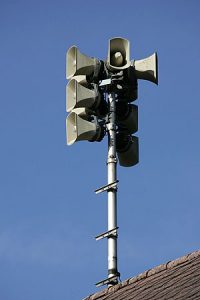Statewide Tornado Safety Drill Is Feb 23 – 10:07 A.M. EST

Photo: Roland Zumbühl
Governor Matt Bevin has signed a proclamation designating Feb 22 – 28 as Severe Weather Awareness Week in Kentucky. Severe weather is Kentucky’s most common threat, as evidenced by the four weather-related, federally-declared disasters during 2015.
“As evidenced by the severe weather events in the first two months of this year; preparedness efforts of our county EM partners, local emergency responders and citizen outreach, made a dramatic difference in ensuring no injuries or loss of life occurred during these responses”, said Michael Dossett, Director of Kentucky Emergency Management. Dossett went on to say, “Testing your plan during Awareness Week, whether by family members or with your co-workers, ensures we are all ready for the next weather hazard that may challenge the Commonwealth”.
As part of severe weather awareness activities, a statewide tornado drill will be conducted in conjunction with the proclamation.
At approximately 10:07 a.m. EST, Tuesday, Feb 23, the National Weather Service (NWS), in partnership with Kentucky Emergency Management (KYEM), the Kentucky Weather Preparedness Committee and Kentucky Broadcasters Association will issue a test tornado warning message.
Across Kentucky, outdoor warning sirens will sound, weather alert radios will activate, and television and radio stations will broadcast the alert; allowing the public the opportunity to practice tornado safety.
The broadcasted test message will emphasize this is only a test of the alert system. During the test alert all Kentuckians, businesses, hospitals, nursing homes, educators and government agencies are encouraged to participate in the tornado drill and update their emergency plans.
As part of Severe Weather Week activities, Kentucky Education Television (KET) will host the popular live viewer call-in show, “Severe Weather – Staying Safe”. A panel of weather experts field questions from the general public. Callers will be registered to receive one of five NOAA Weather Alert Radios which will be awarded at the end of the show. The show will air live on Monday, Feb 22 at 10:00 p.m. EST. More information is available here.
Being prepared for severe weather starts with identifying threats and risks. The first step for each citizen is to become weather-ready by knowing what types of weather hazards that can affect where they live and work, and how the weather could impact them and their family. Citizens should check local weather forecasts regularly, get a NOAA Weather Radio, and sign up for alerts from local emergency management officials. Severe weather comes in many forms and emergency planning should consider the possibility all types of local hazards.
A good tornado plan should:
- Designate a tornado sheltering area in an interior room on the lowest level of a building and away from windows. Basements are best, but if there is no basement, choose an interior bathroom, closet or other enclosed space on the lowest level of a building.
- Ensure employees/family members know where the designated shelter is located
To conduct a tornado drill at home or work:
- Announce the start of the drill.
- Participants should act as though a tornado warning has been issued for the immediate area or a tornado has been sighted nearby.
- They should move as quickly as possible to the designated tornado shelter.
- Once people reach pre-designated safe areas, they should crouch as low as possible to the floor, facing down, covering their heads with their hands.
- Once everyone has reached safe shelter, announce the mock tornado has passed and the drill is complete.
- After the drill, perform an assessment. Determine whether the designated shelter was large enough for everyone, easy to get access and uncluttered.
- Help emergency managers and weather officials improve weather notifications and awareness campaigns by completing a short online survey, available at http://kyem.ky.gov/Preparedness/Pages/Tornado.aspx
If caught outdoors and unable to seek indoor shelter during a tornado warning, lie flat in a nearby ditch or depression and cover your head with your hands. Be aware of the potential for flooding.
Remember, outdoor sirens are designed to warn people outdoors to seek shelter immediately and are NOT designed to warn indoor inhabitants. Tornadoes can, and do, strike during the night when people are more vulnerable and may not have a television or radio turned on when a severe weather warning is issued. A battery back-up weather alert radio is recommended and is the most effective way to monitor, and receive, severe weather watches and warnings because they are always on and ready to sound an alarm and at any time of day or night.
Homes and businesses alike should have and monitor weather alert radios, which transmit NWS severe weather watches and warnings automatically, 24 hours a day.
Weather safety tips, helpful links and resources and the tornado drill survey can be found on the KYEM website at: http://kyem.ky.gov where you can follow KYEMPIO on Twitter, like us on facebook and sign up for mobile alert messages. Additional tornado safety information is also available at http://www.ready.gov/tornadoes.
To receive text cell phone alerts from KYEM, text “FOLLOW KYEMPIO“ to the number 40404 (standard texting rates apply), you can stop at any time by replying ‘STOP”.
If inclement weather is forecasted for Feb 23, the Statewide Tornado Drill will be rescheduled.
 Weather
Weather Traffic
Traffic @LouisvilleDispatch
@LouisvilleDispatch @LouisvilleDisp
@LouisvilleDisp Subscribe
Subscribe
Leave a Reply